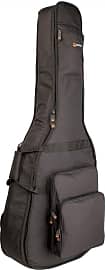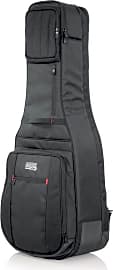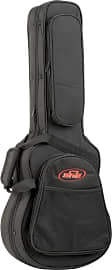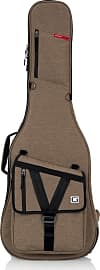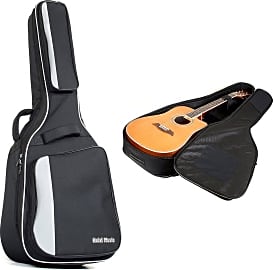The 10 Best Guitar Bags

This wiki has been updated 41 times since it was first published in September of 2015. Whether you’re busking on the city streets, gigging in local bars, or performing all over the world, you'll want to protect your instrument in one of these durable guitar bags. They're ideal for the solo traveling musician or members of a band with a busy tour schedule, but be sure to measure carefully before you make your selection, as an ill-fitting model won't do its job well. When users buy our independently chosen editorial picks, we may earn commissions to help fund the Wiki.
Editor's Notes
February 14, 2020:
Unfortunately, although we like the overall design, we are worried about the quality of the zippers found on the Gator GBE-DREAD, so we've opted to remove it at this time. We've also removed the ChromaCast Acoustic 6-Pocket; it's incredibly inexpensive, but its overall construction is just a bit too flimsy. For those with a tight budget, though, the Hola! Deluxe Padded is still a workable choice (but we must admit it's perhaps not the most attractive design out there). If you want more protection and a sleeker look, the Reunion Blues Double and Mono M80 remain great options. They come sized to fit many types of instruments, including dreadnoughts, and are made with quality materials for the long haul. We've added the Fender Multi-Fit as a top choice, as well, thanks to its soft lining. It is surprisingly affordable, although it doesn't necessarily fit every single electric guitar out there.
Special Honors
Levy's Leather Acoustic The Levy's Leather Acoustic comes in black or brown and has internal string protectors, so it's more than just attractive, it can offer security, too. It's on the more expensive end of the price spectrum, but it's sturdily built, eye-catching, and complete with handles and a pocket. levysleathers.com
The Revelator by Anthology Gear The Revelator by Anthology Gear costs more than some high-quality guitars, but its leather construction is handsome and sure to turn heads wherever you go. A hybrid hard/soft case, it features quality materials down to the smallest details, including industrial-grade thread and sturdy rivet supports. anthologygearwear.com
Gruv Gear Kapsule The Gruv Gear Kapsule is half hard case, half soft bag, giving you a blend of comfort and protection that's hard to beat. The shell is made of durable polycarbonate that's so strong it can withstand being checked in for a flight, and thanks to the snap-on wheels, you won't have to lug it on your back when you get to where you're going. gruvgear.com
You’d Better Protect Your Instrument
Not only are these bags much lighter in weight than their hard-shelled counterparts, but they also have better carrying options.
If you’re a guitar player, you know how deeply your love for your instrument goes, how connected you become to the ax you spend so many hours with in practice and performance. You might come to think of it like a child, taking care to keep its neck oiled and its frets clean, carefully changing the strings and wiping it down after each use. Given how important your guitar is to you, you really ought to have a case that can provide a little bit of protection.
Without a case, there are two terrible things that can happen to your guitar. The first is that it might suffer cosmetic damage. This won’t alter the playability or sound of the instrument, but it could affect your image on stage and it would definitely have a negative effect on the guitar’s resale value. The other potential for risk is to the integrity of the instrument itself. A deep gouge in the wood of the guitar or a crack in the neck would render it all but unplayable, and could result in tremendous repair costs.
You could get your hands on a hard case, which is probably preferable to the soft bags on our list for touring musicians, but a regular gig bag is actually a great idea for most players, and for a number of reasons. One of the most important things that a guitar bag offers over a hard case is ease in portability. Not only are these bags much lighter in weight than their hard-shelled counterparts, but they also have better carrying options. Many include straps akin to those you’d find on a backpack, allowing you to toss it on your shoulders and free up your hands to carry additional gear or open doors.
Many gig bags also offer additional storage compared to hard cases. This is vital for students of the instrument, as it can accommodate things like lesson books that couldn’t fit in cases with less room. If you’re a folk guitarist, you can also use the larger compartments out there to pack things like harmonicas and their holders.
How To Choose The Right Bag For Your Guitar
When you set out to find a nice bag for your guitar, it might seem like the easiest thing to do would be to find the cheapest thing that fits and head to the checkout. While that will put a thin barrier between your guitar and the outside world, it probably isn’t the smartest way to find the best bag for you.
While that will put a thin barrier between your guitar and the outside world, it probably isn’t the smartest way to find the best bag for you.
Sure, fit is plenty important. If your guitar has too much room in the bag, it might bang against anything that’s protruding from the storage compartment, possibly causing a small amount of damage. If your guitar has too little room in the bag, it’ll put too much stress on the bag’s seams, which could cause it to tear or even burst while you’re carrying it, dropping your guitar to the ground.
So, in addition to making sure you’ve got your eyes on a bag that’s the right size and shape for your instrument, you’ll also want it to have as much padding as possible to keep your baby safe. Then, you can focus on some other features.
As we mentioned above, there are some bags on the market that have backpack-style straps on them for easy carrying. Still, if this isn’t your style, you can look for a bag that has a diagonal carrying strap. Either way, there should be small handles that will let you tote the bag along in your hand.
The next thing worth taking a look at are the available storage options on a given model. If you know you don’t need to carry anything else around in your bag, you can get away without any significant storage, but smart musicians know how important it is to keep spares on hand. Extra picks, strings, and parts can mean the difference between performing on the instrument you know or begging a stranger to lend you theirs minutes before your set.
A Brief History Of The Guitar
The development of stringed instruments among the various ancient cultures of the world is tremendously divergent, with different cultures coming close to what we call the guitar today. In some cases, we might be tempted to assume certain instruments to be the natural predecessors of the guitar, such as the lute, but the chronology isn’t quite as simple as that.
The Japanese would go on to develop an odd stringed instrument of their own, the Shamisen, which has a haunting tone and is played with a kind of spatula as a pick.
Ancient cultures around the globe each discovered that plucking a string — usually one from the guts of an animal — created a resonant sound. Being the irrepressibly expressive species that we are, many of those cultures found ways to hang those strings across chambers for resonance, often made from tortoise shells and similar, bowl-shaped materials. These early harps were among the guitar’s earliest ancestors.
It’s the Egyptians who appear to have honed an instrument most similar to the guitar before its more modern developments, as can be seen both in paintings datings at least as far back as the 15th century B.C.E., and in person, as discovered in the tomb of Egyptian singer Har-Mose, who was buried near a queen who loved his playing.
Meanwhile, in Asia, other cultures developed similar instruments, many of which included the “tar” as in gui-tar. Tar is the sanskrit word for string, as in the sitar or the dotar. The Japanese would go on to develop an odd stringed instrument of their own, the Shamisen, which has a haunting tone and is played with a kind of spatula as a pick.
Guitars as we know them began to make appearances around the time of the Renaissance, though these were rarely the six-stringed variety. Most had five strings tuned A, D, G, B, E, with today’s low E string left off.
The six-string version with a fat, low E was popularized in the early decades of the 19th century, and as its popularity grew, so, too did the technology fueling recorded music, for which the clear trebly tones of the guitar’s upper register were a perfect match. The guitar continues to evolve today, with the advent of electrical pickups, experiments with computer interfaces, and even a seventh string.





